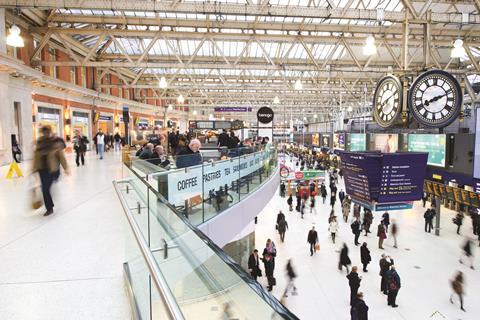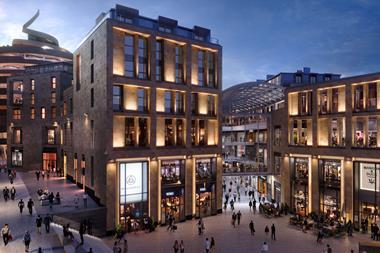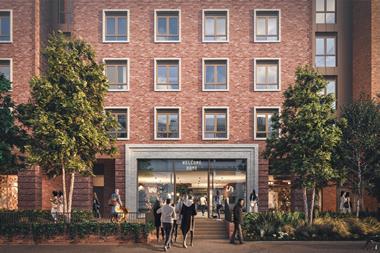Retailers are increasingly considering new types of locations for trading, from quirky one-off sites to expanding transport hubs.

If shopping centres and high streets are working hard to become destination meeting places, then perhaps it is no surprise that those places where people already congregate should see the opportunity to reinvent themselves as retail hot spots.
First it was airports - and retail development continues, with plans afoot for London Gatwick - and now UK train stations, a number of which have already been transformed. Network Rail has been at the heart of this transition and, not surprisingly, has been quick to promote the strong performance of its redeveloped locations, which include King’s Cross and Waterloo stations in London and Manchester Piccadilly.
Retail sales figures from 17 of Network Rail’s busiest stations show like-for-like growth of 2.4% for the three months to the end of September 2012. This covers more than 580,000 sq ft of retail space comprising 520 units. It is the ninth consecutive quarter in which Network Rail’s retail has outperformed British Retail Consortium figures for the high street.
Peter Courtney, a senior director at property consultancy Lunson Mitchenall, says the retail development potential of stations is not restricted to the transport hub. He cites King’s Cross as an example of a far broader retail regeneration opportunity. “It has been an evolution, and the creation of a retail and food and beverage hub at stations such as King’s Cross is really just the first part,” he explains. “Further opportunities arise as the location becomes known as a destination. At King’s Cross we could be looking at developing that opportunity over the next 10 to 15 years.”
Courtney adds that such sites offer people a place to meet and spend time, but the key to increasing dwell time is creating an environment that has broad appeal: “One aspect that is particularly attractive for retailers is those hubs where international visitors and tourists congregate and, again, King’s Cross is a great example.”
Taking space in a station is no guarantee of success, says Jonathan De Mello, director of research at property agent CBRE, so some cultural adjustments maybe required. “Previously, the rail network and London Underground had a very poor retail offer and these redevelopments are changing that dramatically,” he says.
“But we have seen a mixed performance from the retailers with some showing poor conversion rates.” To make a location work, De Mello says the retailer has to have the right offer and adapt trading and merchandise to the requirements of travellers and those working or living around the station.
For that reason, says Courtney, some of the biggest opportunities lie in those locations least exploited. He explains: “For example, Birmingham New Street has suffered from poor retail provision and overcrowding but
its location and the redevelopment work make it a great opportunity for retailers. However, trading from such sites often means working from much smaller stores and for successful retailers the art is adapting the offer to the size of the unit.”
Gifting was the best performing sector in the three months to the end of September 2012, according to Network Rail, recording a 30.8% increase. Food and beverage operators continued to perform strongly, with sales growing by 18.5%. David Biggs, director of property at Network Rail, adds: “These are excellent results, and show that the high levels of footfall guaranteed in stations continue to give our retail partners the edge over the high street. Income from retail is a vital funding stream for Network Rail.”
Following the lead
Of course, railway stations have taken their lead from airport operators, which have been developing their international retail offer over the past two decades. De Mello notes that this strategy is continuing to pay off. He says: “Retail and food and beverage have become extremely important to airport operators, earning them huge amounts of money. Indeed some of the food offers at Heathrow T5 are achieving phenomenal results.”
He is less certain, however, of recent moves to further captialise on the airport retail market by developing shopping centres close by. He observes: “Will people really travel from the airport to a mall and what can you put in your hand luggage anyway? These developments are fraught with potential problems.”
Property agent and consultancy Jones Lang LaSalle has recently created a specialist transport division, which is acting for the renovation of Gatwick and is expected to make some retail announcements soon. Retail director Fiona Hamilton says in a time of few growth opportunities, transports hubs are one of the bright spots for retailers.
She adds: “It’s about creating models that work, which reflect the different formats required for transport hubs, and about carefully working through the tenant mix.” Hamilton says there is room for a lot more aspirational retail in airports and points out it’s a great foot in the door to global retailing. “For the retailer, it is also a great way of building an international presence and we are working with retailers looking to break into new markets.
The visibility that airport retail gives them is an alternative to setting up in a new country.”
Away from transport hubs, retailers are also colonising other areas not traditionally known for retail, such as visitor attractions. Courtney points to London’s South Bank as an example. He explains: “Twenty years ago,
it was mostly frequented by skateboarders and drug dealers but it is now a vibrant area which, again, attracts both domestic and international visitors.
Canary Wharf, meanwhile, has become the poster boy for creating a retail destination from a non-traditional location. Courtney says: “Beyond the main mall there is a very significant retail and food and beverage offer, making use of the transport links and the office catchment during the week and tourists at the weekend.” As a retail offer strengthens, it can change and evolve the nature of a location.
Unique appeal
Nick Symons, partner at property agent MMX Retail, says there is a strong desire to differentiate in a cookie-cutter world. “Certainly there are a number of retailers looking for quirkier sites that create something unusual.
We can see that with Jack Wills or Sweatshop, which has taken a space under three arches at Clapham North station in London,” he says. “This strategy often works for destination retailers, which don’t need to be with other retailers, and once they take an untraditional site they can often start to transform an area into a stronger retail location.”
The grocers have also innovated, converting a variety of buildings into stores and, in the last two years alone, 200 former pubs have been transformed into convenience shops. At Springhill in Birmingham, Tesco customers can use an undercover doorway that links directly to the local library.

However, it is the transport hubs that stand out as a real opportunity for retailers. For Jones Lang LaSalle’s Hamilton, they represent the “last big exciting opportunity in the physical environment” as we move into the ecommerce age.
At present it remains a relatively immature retail market - retailers that have yet to consider new locations might want to do so before they miss the boat.
Worldwide shopping takes flight

The growth in travel retail is far from a UK-only phenomenon.
According to payments system provider ACI Worldwide, in 1990 just 30% of global airport turnover came from commercial operations, climbing to 50% in the mid-2000s.
It is expected to reach 60% in the next five years. Similarly, Generation Research says in 2001 duty free sales at airports worldwide totalled $8.9bn (£5.7bn), and by 2012 it accounted for about $25bn (£16bn).
The first reason for the growth is that many retailers - especially in the fashion sector - view airport stores as a great way to develop internationally. The second is that aviation business margins have been eroded and, as a consequence, revenue from other business has become critical for airports.
For example, commercial operations at Amsterdam Airport Schiphol represent 23% of total revenue and 45% of the airport’s operating revenue. At Paris Charles de Gaulle Airport, the total area dedicated to retail rose from 350,000 sq ft in 2004 to about 500,000 sq ft in 2010 and it will increase again to 590,000 sq ft by 2015. It is hoped this will help Aéroports de Paris to achieve sales per passenger of €17.40 (£15), compared with a little under €13 (£11.20) at present.
Railway stations are also maturing. In Europe the main landlords are upgrading stations mirroring what has been seen in the UK. In Italy, Grandi Stazioni aims to transform its 13 major national terminals into malls, with the most developed being Rome Termini, Milano Centrale, Napoli Centrale and Torino Porta Nuova.
The rail deal

London welcomed two new rail concourses in 2012 at King’s Cross and Waterloo.
At King’s Cross, an airport-style mall approach has been taken to create 30 units, including a debut from Australian book retailer Watermark and the first station store for fashion retailer American Apparel.
It is housed within a striking glass and steel roof structure, which has been blended with the Grade I-listed station’s heritage to create a space for passengers that is three times larger than the previous concourse. It also incorporates improved links to both the London Underground network and St Pancras International station.
The original concourse is being transformed into a new public space, which is larger than Leicester Square and scheduled to open in September 2013.
As well as Watermark, which also has stores in Australia, the US and Canada, the retail offer includes a Harry Potter store, opening to capitalise on the Platform 93/4 feature.
Watermark operator LS Travel Retail decided to use the station as its foothold in the UK, opening a store despite the difficult environment. Fin Casey, managing director for the UK and Ireland, says: “As a travel retail specialist we are well prepared with our offer, although every store will need adjusting as we get used to trading the space. But it’s important to reflect more than just the needs of travellers - major transport hubs are becoming destinations in themselves.”
Meanwhile, there is also a more diverse food and beverage offer at King’s Cross, which includes Leon, Giraffe, Prezzo and Yalla Yalla. Network Rail has eschewed fast food at the station, with many of the restaurants opening their first station outlets and reorienting their proposition to deal with the fast turnaround times required at such a location.
Retailers are on turnover leases with a minimum guaranteed based on three- or six-year terms, with food and beverage on about seven-year leases.
The completion of 20,000 sq ft of new retail space accessed by a new 220-metre balcony at Waterloo station last July also attracted new names to the station, including Yo! Sushi, Fat Face, Hotel Chocolat, Benugo, Oliver Bonas, Links of London, Sports Bar & Grill, Carluccio’s, Thomas Pink and Joules, which made its station debut.
David Biggs, director of property at Network Rail, says: “The launch of our new retail space at Waterloo was a crucial milestone in delivering our vision for retail, creating stations that are destinations in their
own right.”


























No comments yet